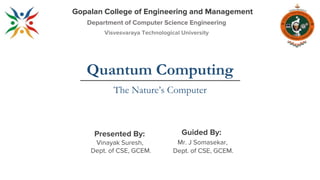
QuantumComputersPresentation
- 1. The Nature’s Computer Quantum Computing Gopalan College of Engineering and Management Department of Computer Science Engineering Visvesvaraya Technological University Presented By: Vinayak Suresh, Dept. of CSE, GCEM. Guided By: Mr. J Somasekar, Dept. of CSE, GCEM.
- 2. • Abstract • Objective • Introduction • History • Scope of the project • Architecture • Working • Advantages • Application • Future Work • Conclusion Contents
- 3. "When you change the way you look at things, the things you look at change" Max Planck, Father of Quantum Physics
- 4. Objective To realise and understand a method of Harnessing and Exploiting the Amazing laws of Quantum Mechanics to process Information.
- 5. Abstract • Quantum computing studies theoretical computation systems that make direct use of quantum-mechanical phenomena, such as superposition and entanglement, to perform operations on data. • Quantum computers are different from digital electronic computers. What's the difference? • Digital computers require data to be encoded into binary digits (bits), each of which is always in one of two definite states (0 or 1). • Quantum computation uses quantum bits (qubits), which can be in superpositions of states.
- 6. How does this difference help in better computation? A quantum computer with n qubits can be in an arbitrary superposition of up to 2^n different states simultaneously while a normal computer that can only be in one of these 2^n states at any one time.
- 7. Introduction • Superposition Superposition is essentially the ability of a quantum system to be in multiple states at the same time, something can be “here” and “there,” or “up” and “down” at the same time. • Entanglement Entanglement is an extremely strong correlation that exists between quantum particles so strong, in fact, that two or more quantum particles can be inextricably linked in perfect unison, even when placed at opposite ends of the universe. This seemingly impossible connection inspired Einstein to describe entanglement as “spooky action at a distance”.
- 8. History • The idea of a computational device based on quantum mechanics was first explored in the 1970's and early 1980's by physicists and computer scientists such as Charles H. Bennett, Paul A. Benioff, David Deutsch, and the late Richard P. Feynman. • They understood that if technology continued to abide by Moore's Law, then the continually shrinking size of circuitry packed onto silicon chips would eventually reach a point where individual elements would be no larger than a few atoms. • In 1994, a mathematician Peter Shor, who was working at AT&T at the time, unveiled that if a fully working quantum computer was available, it could factor large numbers easily.
- 9. • D-Wave Systems, Inc. is a quantum computing company, based in Burnaby, British Columbia, Canada. • On May 11 2011, D-Wave Systems announced D-Wave One, described as "the world's first commercially available quantum computer", operating on a 128-qubit chipset. • On August 20, 2015, D-Wave Systems announced the general availability of the D-Wave 2X system, a 1000+ qubit quantum computer. • This was followed by an announcement on Sept 28, 2015 that it had been installed at the Quantum Artificial Intelligence Lab at NASA's Ames Research Center in collaboration with Google. Now…
- 10. Scope of the Quantum Computing • Useful for scientists for conducting virtual experiments. • we could model the behavior of atoms and particles at unusual conditions. • we could model chemical reactions. • Searching huge amounts of data. • For a phone book with one million phone numbers, finding a number could take one million steps. • In 1996, Lov Grover from Bell Labs discovered that a quantum computer would be able to do the same task with one thousand steps instead of one million.
- 12. Architecture A quantum computer is nothing like a classical computer in design. You can't for instance build one from transistors and diodes. In order to build one, a new type of technology is needed, a technology that enables 'qubits' to exist as coherent superpositions of 0 and 1 states.
- 15. Working User maps a problem into a search for the “lowest point in a vast landscape” which corresponds to the best possible outcome. The processor considers all the possibilities simultaneously to determine the lowest energy required to form those relationships. The quantum computer returns about 10,000 answers in one second. This gives the user not only the optimal solution or a single answer, but also other alternatives to choose from.
- 16. Map coloring using D-wave • Two regions that share a border receive different colors. • Steps include: Turn on one of several qubits. Map a single region to a unit cell. Implement neighbor constraints using inter cell couplers. Clone neighbors to meet all neighbor constraints.
- 17. • Speed to handle process-intensive workloads • The power to scale out depending on business need. • An entirely new way to tackle problems Advantages
- 19. Application 1. Optimization a.Water Network Optimization b.Radiotherapy Optimization c.Protein Folding 2. Machine Learning 3. Object Detection 4. Video Compression 5. Monte Carlo Simulation
- 20. Future Work • New algorithms need to be developed to take advantage of quantum computing. • Computing in very vast fields that haven’t been encroached before can be made possible. • Better technological advancements can result in smaller, cooler quantum computers.
- 21. Conclusion The field of quantum computing is growing rapidly as many of today's leading computing groups, universities, colleges, and all the leading IT vendors are researching the topic. This pace is expected to increase as more research is turned into practical applications.
- 22. "If Quantum Mechanics hasn’t profoundly shocked you, you haven’t understood it yet." Niels Bohr
- 23. Thank you